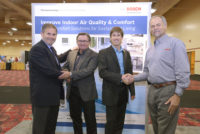TheAmerican Society of Mechanical Engineers (ASME), theAmerican Society of Sanitary Engineering (ASSE)andCSA Standardshave signed an agreement to harmonize five standards concerning automatic compensating valves, anti-siphon fill valves, trap seal primers, pressurized flushing devices (flushometers) and water temperature limiting devices.
The harmonization agreement is designed to help bring clarity to the plumbing community, especially to the manufacturers of devices covered by the harmonized standards.
The agreement between the three organizations states the purpose of the harmonized standards is to assist U.S. and Canadian manufacturers by eliminating duplicate efforts of writing standards for the same products in different countries, which will allow each product to be designed, manufactured and tested to a common standard. This will help provide assurance of consistent, high-quality products, help reduce costs (for producers and consumers) and also help to provide a common basis for product comparisons.
The first harmonized standard, for Performance Requirements for Automatic Compensating Valves for Individual Showers and Tub/Shower Combinations, is expected to be completed and ready for distribution later this year.
Each of the ASME/ASSE/CSA harmonized standards will allow comparable testing of products for the U.S. and Canadian markets. The harmonized standards have an ultimate goal of requiring compliance to one standard and one test, providing a fair process for assessment for manufacturers and buyers in different countries and helping maintain or improve on the current level of product performance.
The harmonized standards will be maintained on an ongoing basis to address new technologies, allow for regional or regulatory differences and move toward performance-based requirements and standards where it is practical and possible.

